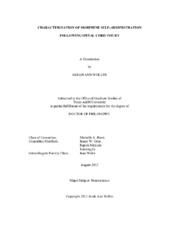| dc.description.abstract | Approximately two-thirds of patients will experience pain following spinal cord injury (SCI). This pain can arise as an immediate consequence of SCI, or can develop over time into chronic, neuropathic pain. Individuals are frequently prescribed opioid analgesics, including morphine, for the treatment of pain in both the acute and chronic phases of SCI. Yet, despite the prevalence of opioid use, no studies have examined the addictive potential of opioids, or their secondary effects, following spinal injury.
These experiments used a clinically relevant self-administration paradigm to examine both addiction and functional recovery after morphine administration. To assess morphine administration in the acute phase of SCI, animals were placed in operant chambers 24-hours following spinal injury. In the chambers, depression of a reinforced lever resulted in an intravenous infusion of morphine (or vehicle). Animals were placed in the chambers for 7, 12-hour sessions and could administer up to 30 mg of morphine per session. Morphine self-administration was also examined in the chronic phase of injury. Animals were placed into operant chambers for 7, 12-hour sessions beginning 14 or 35 days after injury. The amount of morphine administered, as well as recovery of locomotor function and general health, was compared across subjects with SCI and sham (no injury) controls.
In the acute phase of injury, SCI significantly reduced self-administration of morphine, but administration led to decreased recovery of locomotor function and weight loss. In the chronic phase of injury, self-administration did not differ between contused and sham animals. All subjects administered the full amount of morphine available each day. In this phase of injury, morphine administration led to significant weight loss, but did not attenuate recovery of locomotor function.
These studies suggest that spinal injury reduced the addictive potential of morphine in the acute, but not the chronic, phase of SCI. However, acute administration of high doses of morphine decreased recovery of locomotor function. Morphine should not be used in this phase of injury for the clinical treatment of pain. In the chronic phase, opioid use must be closely monitored as use may result in addictive behavior. | en |


